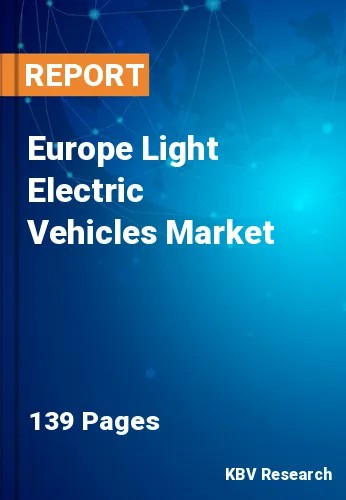The Europe Light Electric Vehicles Market would witness market growth of 8.1% CAGR during the forecast period (2022-2028).
The hybrid electric vehicle (HEV) blends a conventional internal combustion engine (ICE) system with an electric propulsion system (hybrid vehicle drivetrain). The inclusion of an electric powertrain is designed to provide either improved fuel economy or enhanced performance compared to a conventional vehicle. There are various HEV varieties, and the extent to which each operates as an electric vehicle (EV) varies.
The hybrid electric automobile is the most prevalent HEV, however hybrid electric trucks (pickups and tractors), buses, boats, and aircraft also exist. Modern HEVs include efficiency-enhancing technology such as regenerative brakes that transform the vehicle's kinetic energy into electric energy, which is then stored in a battery or supercapacitor. This configuration is known as a motor–generator. This is known as a start-stop system.
Many HEVs cut pollutants by shutting down the engine at idle and restarting it when necessary. Because the hybrid's gasoline engine is often smaller than that of a gasoline-powered vehicle of comparable size, hybrid-electric vehicles emit less pollution from their tailpipes. If the engine is not utilized to directly propel the vehicle, it can be geared for maximum efficiency, further enhancing fuel efficiency.
Europe is one of the largest vehicle producers in the world. The company's automotive industry is one of Netherlands's leading industries. According to the International Trade Government, turnover in 2019 was roughly €106 billion, or $119 billion, representing 6.2% of Netherlands's GDP and 11% of the country's manufacturing turnover. The move from thermal engines to electromobility (hybrid and electric) is transforming the business, which may create opportunities for makers of automobile components, charging infrastructure, and diagnostic instruments.
The Germany market dominated the Europe Light Electric Vehicles Market by Country in 2021, and would continue to be a dominant market till 2028; thereby, achieving a market value of $7,617 million by 2028. The UK market is anticipated to grow at a CAGR of 7.2% during (2022 - 2028). Additionally, The France market would exhibit a CAGR of 9.1% during (2022 - 2028).
Based on Vehicle Category, the market is segmented into 2-wheelers, 3-wheelers, and 4-wheelers. Based on Vehicle Type, the market is segmented into e-scooter, e-ATV/UTV, Neighborhood Electric Vehicle, e-bike & Motorcycle, e-lawn Mower, Autonomous Forklifts, Delivery Robots & Electric Industrial Vehicle, and Others. Based on Component Type, the market is segmented into Battery Pack, Electric Motor, Motor Controller & Power Controller, Inverters, and e-brake Booster & Power Electronics. Based on Application, the market is segmented into Personal Mobility, Shared Mobility, Recreation & Sports, and Commercial. Based on Power Output, the market is segmented into Less than 6 kW, 6-9 kW, and 9-15 kW. Based on countries, the market is segmented into Germany, UK, France, Russia, Norway, Netherlands, and Rest of Europe.
Free Valuable Insights: The Global Light Electric Vehicles Market will Hit $130.4 Billion by 2028, at a CAGR of 8.9%
The market research report covers the analysis of key stake holders of the market. Key companies profiled in the report include Tesla, Inc., BMW Group, Columbia Vehicle Group Inc. (Nordic Group of Companies, Ltd.), Godrej Group (Godrej Material Handling), Kion Group, Yamaha Motor Co., Ltd., Textron, Inc., Polaris, Inc., BYD Company Ltd., and Toyota Industries Corporation.
By Vehicle Category
By Vehicle Type
By Component Type
By Application
By Power Output
By Country
Our team of dedicated experts can provide you with attractive expansion opportunities for your business.

